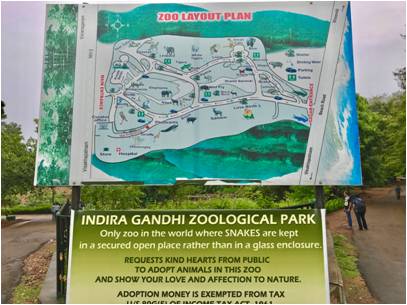Zoological Parks: A zoological park, commonly known as azoo, it is a facility that houses and exhibits a diverse range of animal species for public viewing, education, conservation, and scientific research purposes. Zoological parks play a crucial role in promoting wildlife conservation, raising awareness about biodiversity, and providing opportunities for people to learn about and appreciate animals from around the world.
The primary objectives of zoological parks are:
Conservation: Zoos contribute to the preservation of endangered species by participating in breeding programs, conservation initiatives, and research projects. They aim to maintain and enhance the genetic diversity of animal populations, with the ultimate goal of reintroducing them into their natural habitats.
Education: Zoos are important educational institutions that offer visitors the opportunity to observe and learn about different animal species up close. They provide informative displays, guided tours, interactive exhibits, and educational programs to enhance public knowledge about wildlife, ecosystems, and environmental issues.
Research: Many zoos actively engage in scientific research to advance our understanding of animal behavior, biology, ecology, and conservation. Researchers conduct studies on various aspects of animal life, including reproduction, nutrition, habitat requirements, and veterinary care, to improve animal welfare and contribute to conservation efforts.
Recreation and Tourism: Zoos attract millions of visitors each year, providing recreational experiences for families, students, and tourists. They offer a unique chance to see and connect with animals that may be difficult to encounter in the wild, fostering a sense of wonder and appreciation for the natural world.
Zoological parks strive to provide suitable habitats that mimic the natural environments of the animals in their care. They prioritize animal welfare, ensuring that animals receive proper nutrition, healthcare, and enrichment to support their physical and mental well-being.
Over the years, zoological parks have evolved from mere exhibits to become important centers for conservation, education, and research. They play a critical role in promoting sustainable practices, advocating for the protection of habitats, and inspiring individuals to become stewards of the environment.
Zoological parks are famous for several reasons. Here are some of the key aspects that make zoos famous:
Conservation Efforts: Zoos play a vital role in conservation by housing and protecting endangered species. Many zoos actively participate in breeding programs and reintroduction efforts to help preserve endangered animals and increase their population numbers.
Animal Diversity: Zoos offer a wide range of animal species from different parts of the world. They provide an opportunity for visitors to observe and learn about various animals, including mammals, birds, reptiles, amphibians, and fish.
Education and Research: Zoos are renowned for their educational programs and initiatives. They aim to raise awareness about wildlife conservation, biodiversity, and the importance of protecting natural habitats. Additionally, many zoos conduct research projects on animal behavior, biology, and conservation strategies.
Recreational and Tourist Attractions: Zoos are popular recreational destinations for families, students, and tourists. They provide a unique experience of viewing and interacting with animals, making them appealing to visitors of all ages.
Animal Welfare: Famous zoos prioritize the well-being of animals in their care. They ensure that animals receive proper nutrition, veterinary care, and enrichment activities to support their physical and psychological health.
Architectural and Natural Beauty: Some zoos are renowned for their architectural design and integration with natural surroundings. They create aesthetically pleasing environments for both animals and visitors, often incorporating natural landscapes and habitats.
Historical Significance: Several zoos have a rich history and heritage, being established many years ago. These zoos have witnessed the growth and development of animal care and conservation practices over time.
Examples of famous zoos worldwide include the San Diego Zoo in the United States, the Singapore Zoo, the London Zoo in the United Kingdom, and the Berlin Zoo in Germany. These zoos have gained international recognition for their contributions to conservation, research, and public engagement.
Need and importance of zoo parks
Top of Form Zoo parks serve several important purposes and play a significant role in society. Here are some of the reasons highlighting the need and importance of zoo parks:
Conservation: One of the primary roles of zoo parks is to conserve and protect endangered species. Many species face threats in the wild due to habitat loss, poaching, and other factors. Zoo parks provide a safe haven for these animals, implementing breeding programs and conservation initiatives to maintain their populations.
Education and Awareness: Zoo parks are valuable educational tools. They offer opportunities for people, especially children, to learn about different species, their habitats, and conservation efforts. Zoos often organize educational programs, guided tours, and interactive exhibits to raise awareness about biodiversity and environmental issues.
Research and Science: Zoo parks contribute to scientific research and study. They provide researchers with access to various animal species for studying behavior, biology, and conservation strategies. Zoos also participate in collaborative research programs aimed at improving animal welfare, reproduction, and veterinary care.
Species Preservation: Zoo parks often take part in species preservation initiatives, such as captive breeding programs. By carefully managing populations and genetic diversity, they help ensure the survival of endangered species that might otherwise face extinction.
Environmental Stewardship: Zoo parks promote environmental stewardship by advocating for conservation and sustainable practices. They often emphasize the importance of protecting natural habitats and biodiversity, encouraging visitors to make informed choices to help preserve the planet.
Recreation and Tourism: Zoo parks provide recreational opportunities for visitors. Families, students, and individuals can enjoy observing and learning about animals from around the world. As popular tourist attractions, zoo parks contribute to local economies by attracting visitors and generating revenue for the surrounding areas.
It is important for zoo parks to uphold ethical standards and prioritize animal welfare, ensuring that animals are provided with appropriate care, living conditions, and enrichment to meet their physical and psychological needs.
Overall, zoo parks serve as essential institutions for wildlife conservation, education, research, and promoting a deeper connection between humans and the natural world.
Some of the prominent and famous list of zoological parks (zoos) in India:
- Mysuru Zoo (Sri Chamarajendra Zoological Gardens) – Mysuru, Karnataka
- Delhi Zoo (National Zoological Park) – New Delhi
- Sanjay Gandhi National Park (Borivali National Park) – Mumbai, Maharashtra
- Bannerghatta Biological Park – Bengaluru, Karnataka
- Arignar Anna Zoological Park (Vandalur Zoo) – Chennai, Tamil Nadu
- Nandankanan Zoological Park – Bhubaneswar, Odisha
- Alipore Zoological Gardens – Kolkata, West Bengal
- Indira Gandhi Zoological Park – Visakhapatnam, Andhra Pradesh
- Nehru Zoological Park – Hyderabad, Telangana
- Junagadh Zoo – Junagadh, Gujarat
- Trivandrum Zoo (Thiruvananthapuram Zoo) – Thiruvananthapuram, Kerala
- Lucknow Zoological Garden – Lucknow, Uttar Pradesh
- Kamla Nehru Prani Sangrahalaya – Indore, Madhya Pradesh
- Jaipur Zoo – Jaipur, Rajasthan
- Patna Zoo (Sanjay Gandhi Biological Park) – Patna, Bihar
- Mahendra Chaudhary Zoological Park (Chhatbir Zoo) – Zirakpur, Punjab
- Gopalpur Zoo – Gopalpur, Odisha Sakkarbaug Zoological Garden – Junagadh, Gujarat
- Assam State Zoo cum Botanical Garden – Guwahati, Assam
- Chennai Snake Park Trust – Chennai, Tamil Nadu
- Guindy National Park – Chennai, Tamil Nadu
- Gandhi Zoological Park – Gwalior, Madhya Pradesh
- Thiruvananthapuram Zoo – Thiruvananthapuram, Kerala
- Jijamata Udyaan (Byculla Zoo) – Mumbai, Maharashtra
- Pataleshwar Cave Zoo – Kolhapur, Maharashtra
- Zoological Garden – Nainital, Uttarakhand
- Chhatbir Zoo – Banur, Punjab
- Rani Baug (Victoria Gardens) – Mumbai, Maharashtra
- Sajjangarh Biological Park (Udaipur Zoo) – Udaipur, Rajasthan
- Shri Chhatrapati Shivaji Maharaj Udyan (Rajkot Zoo) – Rajkot, Gujarat
The above Zoological park list includes prominent zoos in India, but there may be additional smaller zoos and wildlife parks across the country as well.
Some of notable zoo parks list in Maharashtra, India:
- Sanjay Gandhi National Park (Borivali National Park) – Mumbai
- Maharajbagh Zoo – Nagpur
- Rajiv Gandhi Zoological Park (Katraj Zoo) – Pune
- Nehru Zoological Park – Aurangabad
- Animal Orphanage and Snake Park – Pune
- Sagar Upvan Zoo – Nashik
- Maharashtra Nature Park – Mumbai
- Veermata Jijabai Bhosale Udyan (Byculla Zoo) – Mumbai
These are just a few examples, and there are many more zoos and wildlife parks across India that contribute to conservation efforts and provide educational experiences to visitors.
One of the most famous zoo parks in India is the Mysuru Zoo, also known as Sri Chamarajendra Zoological Gardens. It is located in Mysuru (formerly known as Mysore), Karnataka, and is one of the oldest and most popular zoos in India. The zoo was established in 1892 and covers an area of about 157 acres.
Mysuru Zoo is home to a wide variety of animals, including elephants, tigers, lions, giraffes, zebras, rhinoceroses, hippos, reptiles, and numerous species of birds. The zoo is known for its successful breeding programs and conservation efforts. It is also renowned for its spacious enclosures, naturalistic habitats, and beautiful landscaping, making it a popular tourist attraction in Mysuru.
Apart from Mysuru Zoo, some other well-known zoos in India include the Delhi Zoo (National Zoological Park) in Delhi, the Sanjay Gandhi National Park (Borivali National Park) in Mumbai, and the Bannerghatta Biological Park in Bengaluru.








